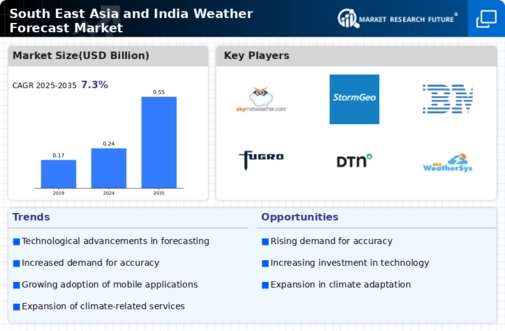Market Share
South East Asia and India Weather Forecast Market Share Analysis
In South East Asia and India, the Weather Forecast Market is characterized by various strategies aimed at securing and expanding market share. Weather forecasting plays a crucial role in various sectors such as agriculture, aviation, maritime, and disaster management, making it essential for companies to navigate the competitive landscape effectively. Several strategies are employed to address the diverse needs of customers and maintain a competitive edge in the market.
Product differentiation serves as a fundamental strategy in the South East Asia and India Weather Forecast Market. Companies strive to differentiate their offerings by providing accurate and reliable weather forecasts tailored to specific industries and applications. This may involve offering specialized forecasting services for agriculture, providing detailed maritime forecasts for shipping companies, or delivering precise aviation weather forecasts for airlines and airports. By tailoring their services to meet the unique requirements of different sectors, companies can attract a wide range of customers and gain a competitive advantage in the market.
Cost leadership is another critical strategy in the South East Asia and India Weather Forecast Market, particularly as customers seek cost-effective solutions without compromising on the accuracy or reliability of weather forecasts. Companies work to optimize their operations, leverage advanced technologies, and streamline data collection and analysis processes to offer competitive pricing for their services. By providing cost-effective solutions that meet customer needs, companies can appeal to budget-conscious clients and gain market share, especially in price-sensitive segments of the market.
Segmentation plays a significant role in market share positioning in the South East Asia and India Weather Forecast Market. Companies identify and target specific market segments based on factors such as industry vertical, geographical location, and customer preferences. For example, they may tailor their forecasting services to meet the needs of agriculture in rural areas, provide specialized forecasts for urban planning and infrastructure development, or deliver customized weather insights for outdoor events and festivals. By understanding the unique requirements of different segments, companies can develop targeted marketing strategies and customized service packages that resonate with their target customers, thereby maximizing their market share within each segment.
Strategic partnerships and collaborations are essential for market share positioning in the South East Asia and India Weather Forecast Market. Companies often form alliances with government agencies, research institutions, technology providers, and industry stakeholders to leverage complementary expertise, resources, and distribution channels. These partnerships enable companies to expand their market reach, enhance their service offerings, and address emerging market opportunities more effectively. For example, collaborations with government agencies may allow weather forecasting companies to access meteorological data and infrastructure, thereby improving the accuracy and reliability of their forecasts.
Brand reputation and trust are critical factors in the South East Asia and India Weather Forecast Market, where accuracy, reliability, and timeliness are paramount considerations for customers. Companies invest in building strong brands that are synonymous with quality, professionalism, and adherence to international standards. By consistently delivering accurate and reliable weather forecasts that meet or exceed customer expectations, companies can earn the trust of clients and foster long-term relationships, thereby solidifying their market share and enhancing their competitive position.
Furthermore, companies in the South East Asia and India Weather Forecast Market must remain agile and adaptable to changes in technology, regulations, and weather patterns. This requires ongoing investment in research and development, data analytics capabilities, and infrastructure to ensure the highest standards of accuracy and reliability. By staying ahead of the curve and offering innovative solutions that meet the evolving needs of customers, companies can maintain their competitive position and seize new opportunities for growth in a dynamic and challenging market.











Leave a Comment